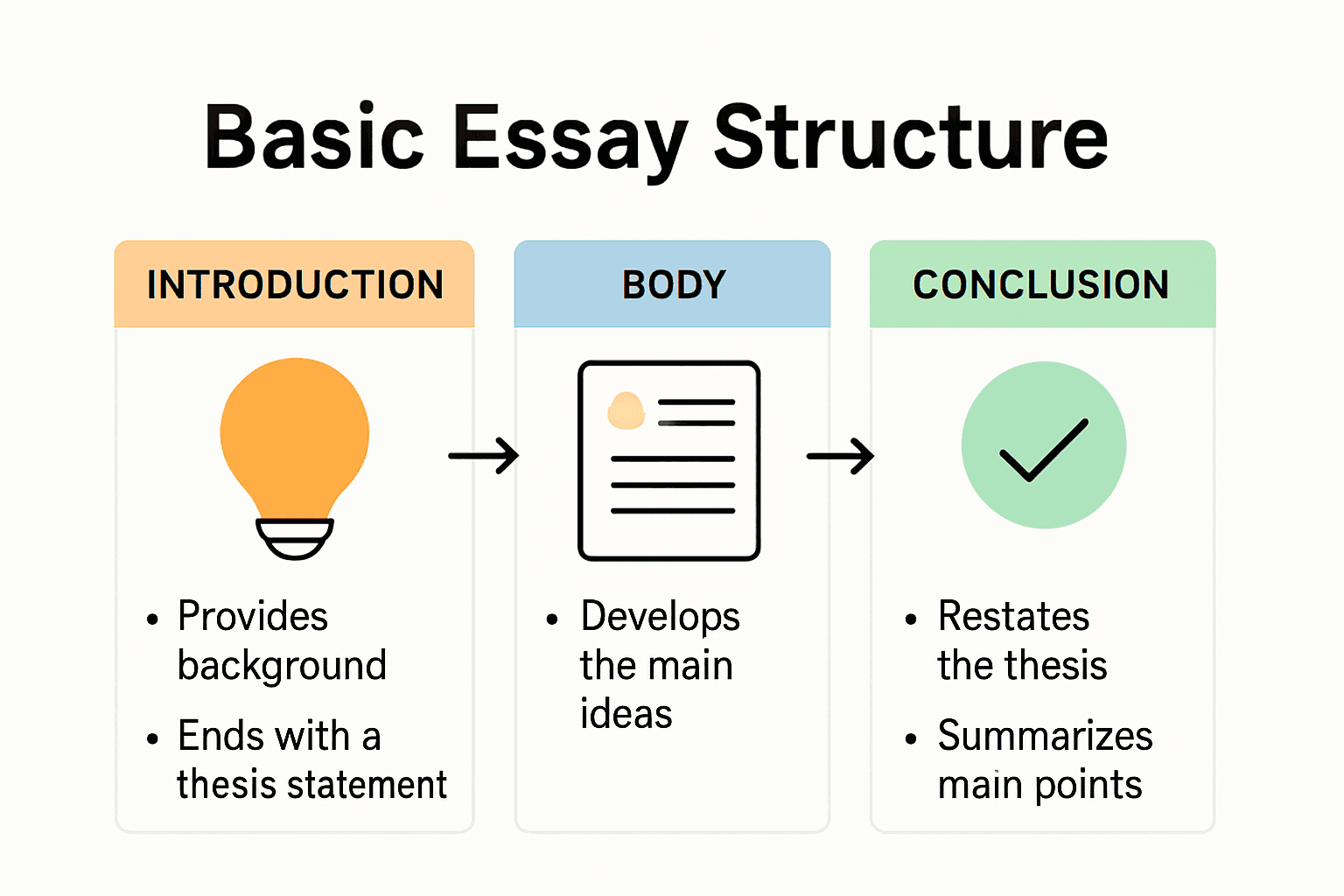Blog
Learning Materials
Exemple de dissertation simple pour les étudiants et les éducateurs 2025
Updated: July 11, 2025

Écrire un essai simple peut sembler être un exercice de débutant basique, mais la vérité est quil constitue la base de tout ce que vous écrirez à lécole et au-delà. Voici la surprise : des recherches de Harvard montrent que les étudiants qui maîtrisent une structure claire dessai ont de meilleures performances académiques dans toutes les matières. La plupart des gens pensent que le secret dune bonne écriture réside dans lutilisation de mots compliqués ou de phrases sophistiquées. En réalité, tout commence par maîtriser la structure la plus simple, et cela a un impact plus grand que ce que lon imagine.
Table des Matières
- Quest-ce quun Exemple dEssai Simple Dockerfile README.md email-templates i18n-config.ts i18nConfig.ts next-sitemap-samwell.config.js next-sitemap-semihuman.config.js next.config.js node_modules package-lock.json package.json process_content.js public scripts src svgr.d.ts translations tsconfig.json Comprendre la Structure de Base dun Essai Dockerfile README.md email-templates i18n-config.ts i18nConfig.ts next-sitemap-samwell.config.js next-sitemap-semihuman.config.js next.config.js node_modules package-lock.json package.json process_content.js public scripts src svgr.d.ts translations tsconfig.json Caractéristiques dun Exemple dEssai Simple Efficace
- Structure dEssai Simple Étape par Étape Dockerfile README.md email-templates i18n-config.ts i18nConfig.ts next-sitemap-samwell.config.js next-sitemap-semihuman.config.js next.config.js node_modules package-lock.json package.json process_content.js public scripts src svgr.d.ts translations tsconfig.json Préparer la Fondation : Stratégies de Pré-Écriture Dockerfile README.md email-templates i18n-config.ts i18nConfig.ts next-sitemap-samwell.config.js next-sitemap-semihuman.config.js next.config.js node_modules package-lock.json package.json process_content.js public scripts src svgr.d.ts translations tsconfig.json Construire le Cadre de lEssai
- Exemple dEssai Simple avec Explication Dockerfile README.md email-templates i18n-config.ts i18nConfig.ts next-sitemap-samwell.config.js next-sitemap-semihuman.config.js next.config.js node_modules package-lock.json package.json process_content.js public scripts src svgr.d.ts translations tsconfig.json Anatomie dun Exemple dEssai Dockerfile README.md email-templates i18n-config.ts i18nConfig.ts next-sitemap-samwell.config.js next-sitemap-semihuman.config.js next.config.js node_modules package-lock.json package.json process_content.js public scripts src svgr.d.ts translations tsconfig.json Développer les Paragraphes du Corps
- Conseils pour Écrire des Essais Clairs Dockerfile README.md email-templates i18n-config.ts i18nConfig.ts next-sitemap-samwell.config.js next-sitemap-semihuman.config.js next.config.js node_modules package-lock.json package.json process_content.js public scripts src svgr.d.ts translations tsconfig.json Développer une Thèse et une Structure Solides Dockerfile README.md email-templates i18n-config.ts i18nConfig.ts next-sitemap-samwell.config.js next-sitemap-semihuman.config.js next.config.js node_modules package-lock.json package.json process_content.js public scripts src svgr.d.ts translations tsconfig.json Stratégies pour la Clarté et la Précision Dockerfile README.md email-templates i18n-config.ts i18nConfig.ts next-sitemap-samwell.config.js next-sitemap-semihuman.config.js next.config.js node_modules package-lock.json package.json process_content.js public scripts src svgr.d.ts translations tsconfig.json Affiner votre Processus dÉcriture
Résumé Rapide
| Point Clé | Explication |
|---|---|
| Comprendre la Structure de Base dun Essai | Un essai simple comprend généralement une introduction, un corps et une conclusion, aidant les étudiants à articuler leurs idées de manière logique et cohérente. |
| Caractéristiques dun Essai Simple Efficace | Les essais efficaces se caractérisent par un objectif clair, une organisation logique, des preuves solides et une citation appropriée, servant de modèles pour lécriture académique. |
| Structure dEssai Simple Étape par Étape | Maîtriser lécriture dessai commence par des stratégies de pré-écriture, suivies par le développement dun cadre clair incluant une introduction ciblée, des paragraphes de corps détaillés et une conclusion résumante. |
| Stratégies pour la Clarté et la Précision | Utilisez un langage clair, des transitions logiques et des preuves pour transmettre efficacement les arguments, assurant une communication cohérente des idées complexes. |
| Affiner votre Processus dÉcriture | Lécriture est itérative ; les brouillons doivent être révisés, les retours recherchés, et les éléments inutiles édités pour améliorer la clarté et la force de largument. |
Quest-ce quun Exemple dEssai Simple
 Un exemple dessai simple représente un format décriture académique fondamental conçu pour aider les étudiants à communiquer des idées de manière claire et efficace. Ces exemples servent de guides pratiques qui démontrent comment structurer des pensées, présenter des arguments et transmettre des informations de manière logique et cohérente.
Un exemple dessai simple représente un format décriture académique fondamental conçu pour aider les étudiants à communiquer des idées de manière claire et efficace. Ces exemples servent de guides pratiques qui démontrent comment structurer des pensées, présenter des arguments et transmettre des informations de manière logique et cohérente.
Comprendre la Structure de Base dun Essai
Au cœur, un exemple dessai simple suit généralement une structure standard en trois parties qui fournit un cadre clair pour exprimer des idées. La structure comprend une introduction qui présente le sujet principal, une section de corps qui développe et soutient largument central, et une conclusion qui résume les points clés et renforce le message principal de lessai.

En savoir plus sur les essentiels de lécriture académique aidera les étudiants à comprendre comment ces composants de base fonctionnent ensemble pour créer un écrit convaincant. Lintroduction commence généralement par un accrocheur qui capte lattention du lecteur, suivi dune déclaration de thèse qui définit clairement largument principal ou lobjectif de lessai.
Les paragraphes du corps contiennent généralement des preuves spécifiques, des exemples et des analyses qui soutiennent la thèse. Chaque paragraphe doit se concentrer sur une idée principale qui se connecte à largument global. Cette approche aide à maintenir la clarté et empêche lessai de devenir dispersé ou flou.
Caractéristiques dun Exemple dEssai Simple Efficace
Les exemples dessais simples efficaces démontrent plusieurs caractéristiques clés qui les rendent précieux en tant quoutils dapprentissage. Selon les recherches en écriture académique de lUniversité de Harvard, ces caractéristiques incluent :
- Objectif Clair : Un essai bien conçu a un objectif spécifique et identifiable
- Organisation Logique : Les idées senchaînent de manière fluide et se connectent de manière cohérente
- Preuves de Soutien Solides : Les affirmations sont soutenues par des exemples ou des recherches pertinents
- Citation Appropriée : Les sources sont correctement référencées et créditées
Voici un tableau résumant les caractéristiques essentielles dun exemple dessai simple efficace et leur importance :
| Caractéristique | Description | Importance |
|---|---|---|
| Objectif Clair | Définit un objectif spécifique pour lessai | Assure la concentration et la direction |
| Organisation Logique | Présente les idées dans une séquence fluide et cohérente | Aide les lecteurs à suivre largument |
| Preuves de Soutien Solides | Utilise des faits, des exemples ou des recherches pour soutenir les affirmations | Renforce la crédibilité et la persuasion |
| Citation Appropriée | Crédite correctement toutes les sources référencées | Évite le plagiat et renforce lautorité |
Les étudiants peuvent utiliser ces exemples comme modèles pour comprendre comment construire leur propre écriture académique. Ils fournissent un guide visuel et pratique pour transformer des pensées abstraites en communication écrite structurée et professionnelle.
Lobjectif principal dun exemple dessai simple nest pas seulement de montrer un format décriture mais de démontrer comment des idées complexes peuvent être communiquées efficacement. En décomposant des concepts compliqués en sections claires et digestes, ces exemples aident les étudiants à développer des compétences en pensée critique et en communication qui vont bien au-delà de lécriture académique.
Que ce soit pour préparer un devoir de lycée ou un article de recherche universitaire, comprendre les éléments fondamentaux dun exemple dessai simple fournit une base solide pour le succès académique. Ces exemples servent de feuilles de route, guidant les étudiants à travers le processus dorganisation des pensées, de développement des arguments et de présentation des informations de manière claire et convaincante.
Il est crucial de pratiquer avec plusieurs exemples, danalyser leur structure et de comprendre comment différents auteurs abordent des sujets similaires. Chaque exemple offre des perspectives uniques sur les stratégies de communication efficaces, aidant les étudiants à affiner leurs propres compétences en écriture et à développer une compréhension plus nuancée de la composition académique.
En étudiant et en imitant ces exemples dessais simples, les étudiants peuvent transformer leur écriture de basique à exceptionnelle, apprenant à articuler leurs idées avec précision, clarté et confiance.
Structure dEssai Simple Étape par Étape
Maîtriser la structure dun essai simple nécessite de comprendre une approche systématique qui transforme des idées brutes en un document académique cohérent. Ce processus étape par étape décompose lécriture dessai en composants gérables, permettant aux étudiants daborder leur écriture avec confiance et clarté.
Préparer la Fondation : Stratégies de Pré-Écriture
Avant de plonger dans lécriture, la composition réussie dun essai commence par une préparation stratégique. Explorez notre guide complet sur le format dessai pour comprendre les étapes initiales critiques. Selon les recherches en écriture académique de lUniversité de Stanford, une pré-écriture efficace implique trois activités essentielles :
- Brainstorming : Générer des idées par lécriture libre, la cartographie mentale ou la liste de sujets potentiels
- Recherche : Collecter des sources crédibles et des informations pertinentes soutenant votre thèse potentielle
- Sélection de Sujet : Choisir un sujet ciblé qui permet une exploration et une analyse significatives
Cette phase préparatoire pose les bases dun essai structuré et convaincant. Les étudiants doivent passer suffisamment de temps à enquêter sur leur sujet, sassurant quils ont suffisamment de matériel pour développer un argument solide.
Construire le Cadre de lEssai
La structure de lessai suit un cadre prévisible mais flexible qui guide les lecteurs à travers une progression logique didées. Selon les experts en écriture académique de lUniversité de Harvard, le cadre standard de lessai se compose de trois sections principales :
- Paragraphe dIntroduction : Présente la thèse centrale et fournit le contexte
- Paragraphes du Corps : Développent et étayent largument principal
- Conclusion : Synthétise les points clés et renforce le message central de lessai
Chaque paragraphe du corps doit contenir une phrase de sujet claire, des preuves de soutien et une connexion à la thèse globale. Le modèle de format de plan dessai peut aider les étudiants à visualiser comment ces composants sinterconnectent.
Le développement efficace des paragraphes nécessite une attention particulière à la progression logique. Chaque paragraphe doit sappuyer sur le précédent, créant un voyage intellectuel fluide qui guide le lecteur à travers des idées complexes. Les phrases de transition et les phrases soigneusement construites aident à maintenir ce flux, empêchant lessai de sembler disjoint ou fragmenté.
Lintroduction sert de porte dentrée à lessai, capturant lattention du lecteur et établissant le paysage intellectuel. Une déclaration de thèse solide agit comme une feuille de route, signalant largument principal de lessai et fournissant un sens clair de la direction. Cette déclaration doit être spécifique, discutable et concise, offrant aux lecteurs un aperçu des idées à venir.
Les paragraphes du corps représentent le cœur de lessai, où les idées sont explorées, analysées et étayées. Chaque paragraphe doit se concentrer sur un concept principal directement soutenant la thèse. Des preuves telles que des citations, des données statistiques ou des opinions dexperts confèrent de la crédibilité à largument. Lanalyse critique transforme la simple description en un discours académique significatif.
La conclusion représente la dernière opportunité de renforcer le message central de lessai. Plutôt que de simplement reformuler la thèse, une conclusion efficace synthétise les points clés, démontre la signification plus large de largument et suggère potentiellement des voies pour une exploration plus approfondie.
En suivant cette approche structurée, les étudiants peuvent transformer leur écriture de brouillons chaotiques en compositions polies et professionnelles. La clé réside dans la compréhension du but de chaque composant et la pratique de techniques de composition cohérentes et délibérées.
En fin de compte, maîtriser la structure dun essai simple consiste à développer une approche systématique pour organiser les pensées, présenter des arguments et communiquer des idées complexes avec clarté et précision. Avec de la pratique et de la patience, les étudiants peuvent développer cette compétence académique essentielle.
Voici un tableau résumant la séquence standard des étapes du processus décriture dessai comme décrit ci-dessus :
| Étape | Description |
|---|---|
| Brainstorming | Générer et organiser des idées par lécriture libre ou la cartographie |
| Recherche | Collecter des sources et des informations pour soutenir votre sujet |
| Sélection de Sujet | Choisir un sujet ciblé et pertinent |
| Création de Plan | Développer un cadre structuré incluant les sections principales |
| Écriture de lIntroduction | Présenter la thèse et fournir le contexte |
| Paragraphes du Corps | Développer des arguments et fournir des preuves de soutien |
| Écriture de la Conclusion | Synthétiser les arguments et souligner la signification plus large |
| Révision & Édition | Réviser les brouillons pour la clarté, la cohérence et la correction |
Exemple dEssai Simple avec Explication
Analyser un exemple dessai simple fournit aux étudiants une feuille de route pratique pour comprendre les techniques décriture académique. Explorez nos exemples décriture complets pour obtenir des informations plus approfondies sur la composition dessais efficaces.
Anatomie dun Exemple dEssai
Décomposons un exemple dessai axé sur le sujet LImportance de la Pensée Critique dans lÉducation. Selon les recherches académiques de lUniversité de Stanford, un essai bien construit démontre des composants structurels clairs et une argumentation intentionnelle.
Paragraphe dIntroduction : La pensée critique représente une compétence fondamentale qui transforme les expériences éducatives dun apprentissage passif à un engagement intellectuel actif. Dans lenvironnement académique complexe daujourdhui, les étudiants doivent développer la capacité danalyser linformation de manière critique, de remettre en question les hypothèses et de construire des arguments raisonnés qui vont au-delà de la compréhension superficielle.
Analyse : Cette introduction accomplit trois objectifs clés :
- Présente une déclaration de thèse claire sur la pensée critique
- Fournit le contexte pour largument
- Établit les enjeux intellectuels de lessai
Développer les Paragraphes du Corps

Paragraphe du Corps 2 : Les applications pratiques de la pensée critique sétendent bien au-delà des milieux académiques. Dans les environnements professionnels, les employeurs classent systématiquement la pensée critique comme une compétence de premier plan. La capacité danalyser linformation, de résoudre des problèmes complexes et de prendre des décisions raisonnées distingue les professionnels exceptionnels des performants moyens.
Paragraphe de Conclusion : La pensée critique nest pas seulement une compétence académique mais une approche fondamentale pour comprendre le monde. En cultivant cette capacité, les étudiants se préparent aux défis intellectuels, au succès professionnel et à un engagement significatif avec des enjeux mondiaux complexes.
Décomposition Structurelle :
- Introduction : Établit largument central sur la pensée critique
- Paragraphes du Corps : Fournissent des preuves, des exemples et des analyses soutenant la thèse
- Conclusion : Synthétise les points clés et démontre la signification plus large
Techniques dÉcriture Clés Démontrées :
- Déclaration de thèse claire et ciblée
- Progression logique des paragraphes
- Utilisation de preuves de soutien
- Transitions fluides entre les idées
- Argumentation équilibrée
Observations Importantes :
Cet exemple dessai illustre plusieurs principes décriture cruciaux. Chaque paragraphe se connecte directement à la thèse centrale, maintenant un fil argumentatif cohérent. Le langage reste académique mais accessible, évitant une complexité inutile tout en présentant des idées sophistiquées.
Les étudiants peuvent tirer plusieurs leçons de cet exemple :
- Développer une thèse claire et spécifique
- Soutenir les arguments avec des preuves crédibles
- Maintenir une structure de paragraphe logique
- Utiliser un langage précis et descriptif
- Créer des transitions fluides entre les idées
En étudiant et en analysant des exemples dessais, les étudiants acquièrent des informations pratiques sur lécriture académique efficace. Lobjectif nest pas de copier ces exemples mot pour mot mais de comprendre les principes sous-jacents dune communication claire et convaincante.
Rappelez-vous que chaque essai représente un voyage intellectuel unique. Bien que les lignes directrices structurelles fournissent un cadre essentiel, lécriture la plus convaincante émerge dune pensée originale, dune analyse minutieuse et dune véritable passion pour lexploration des idées.
Conseils pour Écrire des Essais Clairs
Maîtriser lart de lécriture dessais clairs nécessite des approches stratégiques qui transforment des pensées complexes en compositions académiques cohérentes. Explorez notre guide complet sur le format décriture pour élever vos compétences en écriture et développer une approche systématique de la composition dessais.
Développer une Thèse et une Structure Solides
Un essai convaincant commence par une déclaration de thèse robuste et une structure bien organisée. Selon les recherches en écriture académique de lUniversité de Harvard, une thèse efficace doit être :
- Spécifique : Définir clairement largument central de lessai
- Discutable : Inviter à la discussion et à lanalyse intellectuelles
- Concise : Communiquer lidée principale en une seule déclaration puissante
La thèse agit comme une feuille de route, guidant à la fois lécrivain et le lecteur à travers le voyage intellectuel. Les recherches du Writing Center de Stanford suggèrent quune thèse bien conçue fournit un cadre pour organiser les pensées et maintenir la concentration tout au long de lessai.
Pour aider à comparer les qualités dune déclaration de thèse efficace, voici un tableau décrivant les qualités indispensables et leurs objectifs :
| Qualité de la Thèse | Description | Objectif |
|---|---|---|
| Spécifique | Définit clairement largument principal de lessai | Fournit une direction claire |
| Discutable | Peut être argumenté sous différents angles | Engage lanalyse critique |
| Concise | Communiquée en une seule phrase percutante | Améliore la clarté et la concentration |
Stratégies pour la Clarté et la Précision
Communiquer des idées avec clarté nécessite des techniques décriture délibérées. Les experts académiques recommandent plusieurs stratégies clés :
-
Utiliser un Langage Clair et Direct Évitez la complexité inutile. Choisissez des mots qui transmettent précisément votre signification. Lécriture académique doit être sophistiquée mais accessible. Éliminez les phrases redondantes, la voix passive et les structures de phrases trop complexes.
-
Créer des Transitions Logiques entre les Paragraphes Chaque paragraphe doit senchaîner de manière fluide avec le suivant. Utilisez des phrases de transition qui créent des connexions intellectuelles. Ces ponts aident les lecteurs à comprendre comment les idées individuelles se rapportent à largument plus large.
-
Soutenir les Arguments avec des Preuves Les preuves transforment les opinions en arguments crédibles. Les lignes directrices en écriture académique du MIT soulignent limportance de :
- Citer des sources crédibles
- Utiliser les citations directes avec parcimonie
- Expliquer comment les preuves soutiennent votre thèse
- Analyser les preuves de manière critique
Affiner votre Processus dÉcriture
Lécriture dessais efficace est un processus damélioration continue. Les écrivains académiques réussis recommandent plusieurs pratiques clés :
- Rédiger et Réviser : Écrire plusieurs brouillons, en se concentrant sur différents aspects à chaque révision
- Lire à Voix Haute : Entendre votre écriture aide à identifier les formulations maladroites et les problèmes structurels
- Chercher des Retours : Les perspectives externes peuvent révéler des angles morts dans votre argument
- Éditer Sans Pitié : Supprimer les mots inutiles et resserrer votre prose
Les erreurs décriture courantes à éviter incluent :
- Des déclarations de thèse vagues
- Des affirmations non étayées
- Une argumentation incohérente
- De mauvaises pratiques de citation
Les écrivains professionnels comprennent que lécriture claire émerge dune pratique disciplinée. Chaque essai représente une opportunité daffiner les compétences en communication, de développer la pensée critique et de sengager avec des idées complexes.
Rappelez-vous que lécriture est une compétence développée par un effort constant. Aucun écrivain ne produit une prose parfaite en un seul brouillon. Les écrivains académiques les plus réussis embrassent la révision comme une partie essentielle du processus créatif.
En fin de compte, lécriture dessais clairs consiste à communiquer des idées avec précision, passion et rigueur intellectuelle. En appliquant ces stratégies de manière cohérente, les étudiants peuvent transformer leur écriture de simple texte en un discours académique convaincant.
Questions Fréquemment Posées
Quest-ce quun exemple dessai simple ?
Un exemple dessai simple est un format décriture académique de base qui aide les étudiants à communiquer des idées de manière claire et efficace, comprenant généralement une introduction, des paragraphes de corps et une conclusion.
Comment puis-je améliorer mes compétences en écriture dessai ?
Améliorer les compétences en écriture dessai implique de pratiquer lécriture structurée, de développer une thèse claire, de soutenir les arguments avec des preuves et de réviser les brouillons pour améliorer la clarté et la cohérence.
Quels sont les composants clés dun essai simple ?
Les composants clés dun essai simple incluent une introduction avec une déclaration de thèse, des paragraphes de corps qui développent et soutiennent la thèse, et une conclusion qui résume les points principaux et renforce largument central.
Pourquoi est-il important pour les étudiants de comprendre la structure des essais ?
Comprendre la structure des essais est important car cela aide les étudiants à articuler leurs idées de manière logique, améliore la clarté de lécriture et améliore les performances académiques dans diverses matières.
Ne Laissez Plus la Structure des Essais Vous Freiner—Débloquez une Écriture Académique Sans Effort
De nombreux étudiants luttent avec lorganisation claire, le flux logique et le maintien de loriginalité lorsquil sagit décrire des essais. Comme larticle le souligne, maîtriser une structure dessai simple et maintenir la clarté peut sembler accablant. Dinnombrables étudiants se retrouvent coincés à réviser des brouillons, à se débattre avec des règles comme MLA ou APA, ou à sinquiéter du plagiat accidentel. Si vous avez lu sur les défis des introductions claires, des corps organisés et des citations crédibles et avez pensé, Cest moi, il est temps de passer à létape suivante.

Découvrez la manière la plus intelligente de mettre ces concepts dessai en pratique. Samwell.ai utilise une technologie avancée dIA et Semihuman.ai pour vous guider étape par étape dans la construction dessais solides qui respectent les normes académiques. Générez instantanément des plans clairs, obtenez un soutien ciblé pour lédition et appliquez une citation parfaite à chaque brouillon. Passez à laction maintenant et voyez comment Samwell.ai transforme votre processus décriture. Commencez avec une aide à lessai de haute qualité conçue pour les étudiants et les éducateurs qui ne veulent pas se contenter de résultats moyens. Visitez Samwell.ai pour commencer à écrire avec confiance dès aujourdhui.
Recommandé
- Maîtriser le Format dEssai Informatif : Un Guide Étape par Étape
- Guide du Format Standard dEssai pour 2025 : Structure, Conseils et Exemples
Generate essays with Samwell.ai
Whether you’re a publisher, professor, journalist, or student, let us tailor a plan just for you.Articles les plus lus

Votre guide pour réussir la rédaction dun essai
Conseils dexperts pour rédiger une dissertation - de la formulation dune thèse à la structuration efficace de votre dissertation.

Conseils pour la rédaction : Stratégies pour maîtriser lécriture
Améliorez votre rédaction dessais avec des conseils dexperts sur lanalyse, la création de thèse et la structure percutante.

Comment rédiger un essai de réflexion critique : Conseils dexperts
Conseils dexperts pour rédiger un essai de réflexion critique. Apprenez à structurer, choisir des sujets et utiliser efficacement les preuves.

Comment écrire une bonne accroche : Un guide étape par étape
Maîtrisez lart de créer un bon accroche avec notre guide. Créez des ouvertures captivantes pour une première impression mémorable.
